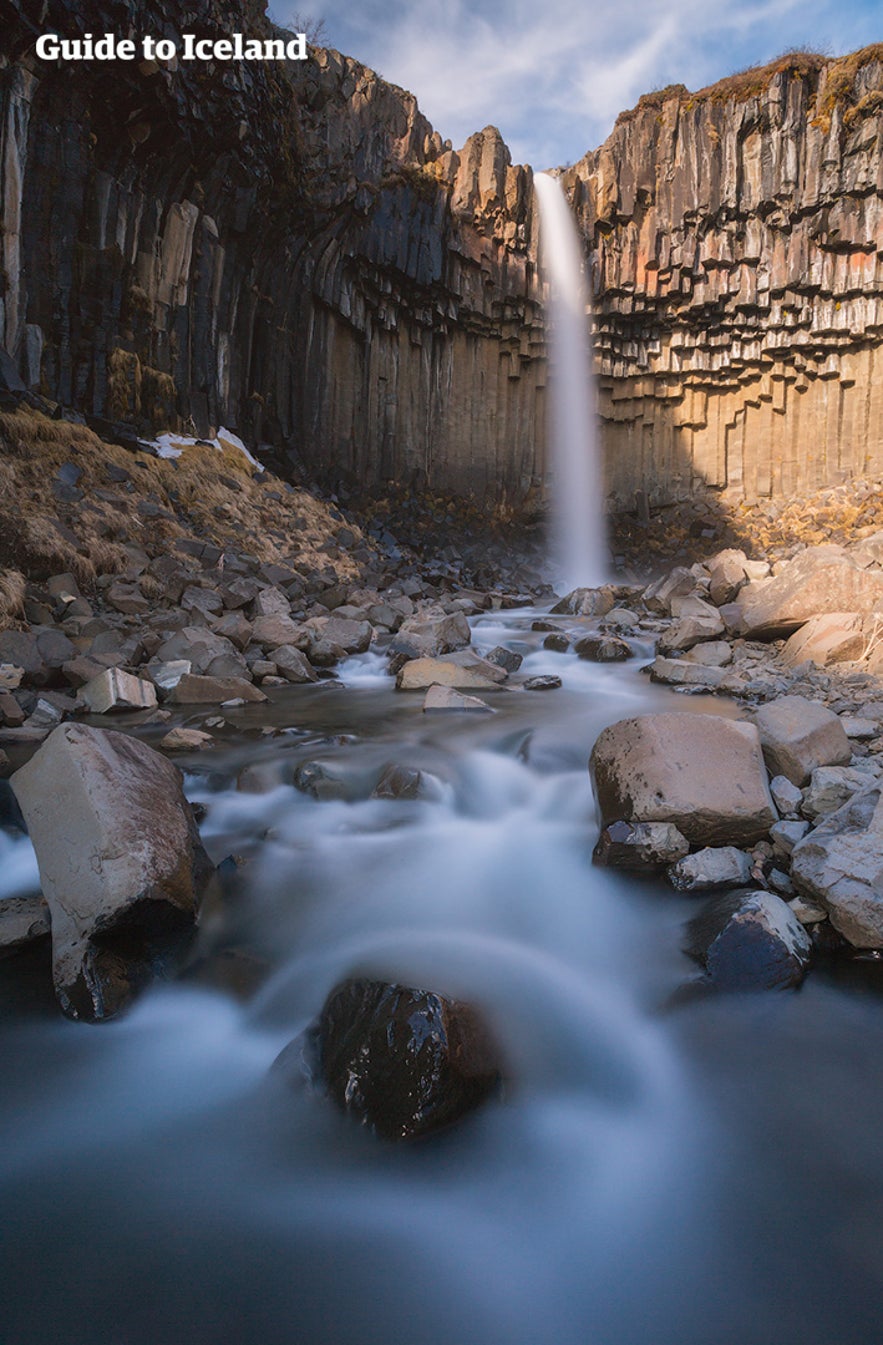Svartifoss, in spite of being just 20 meters (66 feet) tall, and not particularly powerful, is one of Iceland’s most popular waterfalls. The beauty of its formation and surroundings draw thousands of guest a year and have inspired artists for centuries.
No guided tours to Svartifoss are available, so to reach it, we recommend you rent a car or do a self-drive tour and visit Skaftafell in South Iceland, where it is located.
The Basalt Columns of Svartifoss
 Svartifoss is best renowned for the hexagonal basalt columns that surround it and lay shattered at its base. These columns, which are very dark, lend the feature its name; Svartifoss means ‘Black Falls’.
Svartifoss is best renowned for the hexagonal basalt columns that surround it and lay shattered at its base. These columns, which are very dark, lend the feature its name; Svartifoss means ‘Black Falls’.
These columns are found in other places in Iceland, such as the Gerðuberg cliffs on the Snæfellsnes Peninsula, and on Reynisfjara beach on the South Coast. At none of these locations, however, is there a cascade of foaming white water to add to the beauty and fantasy of the site.
The geology surrounding Svartifoss has inspired many artists and architects, spanning generations. To list them all would be impossible, but perhaps the most notable is Hallgrímskirkja, the largest church in Reykjavík, which took elements of Svartifoss’s columns and Thor’s hammer in its design.
The capital’s National Theatre also drew inspiration from Svartifoss, as did the artwork ‘Milestones’ on Viðey Island, by Richard Sierra.
Location of Svartifoss

Svartifoss is located in the Skaftafell Nature Reserve, a place once so beautiful it was once its own national park; since, it has become enveloped into the greater Vatnajökull National Park.
This reserve is renowned for it diverse and spectacular sceneries. It is partly forested in birch, partly covered in lava, divided by rivers and streams, and has many glacier tongues and lagoons within its boundaries.
Avid hikers, photographers and nature lovers, therefore, find Skaftafell to be an oasis of beauty.
To many, Svartifoss is its highlight. The hike from the Skaftafell Visitors’ Centre to the waterfall is just over thirty minutes, and though relatively easy, requires a reasonable level of fitness and decent hiking boots.
Sites Surrounding Svartifoss
Svartifoss, within Skaftafell, has a host of sites that compete for attention from visitors. Perhaps most notable of these is Svínafellsjökull, one of the country’s most popular ice caps for glacier hiking.
Visitors are encouraged to spend several hours following different treks in the path, to discover a whole host of unspoiled spots of incredible natural beauty.
If travelling to Skaftafell from Reykjavík, the journey is direct, going east along Route 1. The four hours it should take you is likely to extend much longer, however, as you stop off at the many sites en route. These include the marvellous waterfalls of Seljalandsfoss and Skógafoss, the glaciers Mýrdalsjökull and Eyjafjallajökull, and the cliffs of Dyrhólaey and Reynisdrangar.
Unfortunately, Svartifoss and Skaftafell are often both overlooked by travellers racing their way to the Jökulsárlón glacier lagoon and Diamond Beach, which are half an hour further along Route 1.
While these sites are majestic places, where you can see enormous icebergs cruise from a vast lake to the ocean, amongst dozens of playing seals, Svartifoss still stands up as a natural highlight next to them, and visitors should still attempt to see it.
FAQs about Svartifoss
1. What is Svartifoss?
Svartifoss, or the Black Falls, is a unique waterfall located in Skaftafell in Vatnajökull National Park, southeast Iceland. The waterfall is surrounded by dark lava columns, which give rise to its name.
2. What makes Svartifoss unique?
Svartifoss is well-known for its dramatic surroundings, particularly its amphitheater of dark hexagonal basalt columns, from which the waterfall gets its name. These columns form through the slow cooling of a thick lava flow. The basalt columns have provided inspiration for Icelandic architects, most notably in the design of Hallgrímskirkja, a renowned church in Reykjavik.
3. How high is Svartifoss?
Svartifoss has a drop of approximately 20 meters or about 66 feet.
4. How can I get to Svartifoss?
The waterfall is located within Vatnajökull National Park. The hike from the Skaftafell visitor center to Svartifoss takes about 1.5 hours round trip. The trail is well-marked and moderately difficult, with some uphill sections.
5. Can I visit Svartifoss year-round?
Yes, Svartifoss can be visited year-round. However, the difficulty of the hike to the waterfall may increase in winter due to icy or snowy conditions.
6. Is there an admission fee to visit Svartifoss?
As of my knowledge cutoff in September 2021, there was no admission fee for Vatnajökull National Park or Svartifoss. However, there might be a parking fee at the Skaftafell visitor center.
7. What should I wear to visit Svartifoss?
Visitors are advised to dress in layers and wear sturdy shoes suitable for hiking, as weather in Iceland can be unpredictable and change quickly. Waterproof clothing is also recommended due to the spray from the waterfall.
8. Is it safe to visit Svartifoss?
Yes, it's generally safe to visit Svartifoss, but like with any natural site, it's important to respect the environment, stay on designated paths, and take care when walking on uneven or slippery surfaces.
9. Is Svartifoss wheelchair accessible?
Unfortunately, due to the nature of the trail that leads to the waterfall, Svartifoss is not easily accessible for those using wheelchairs or with limited mobility.









